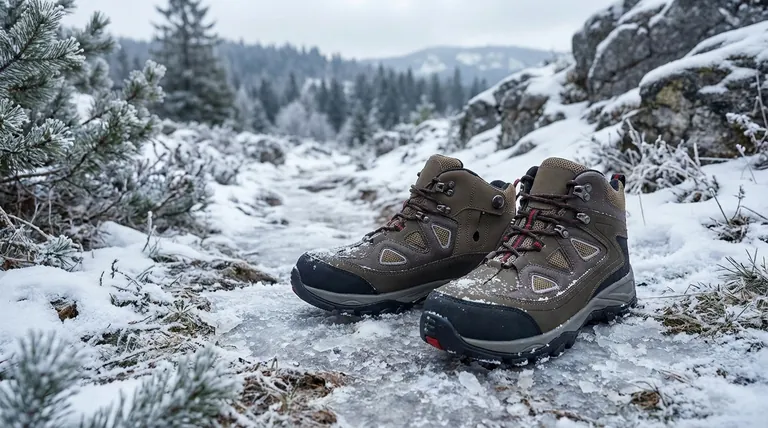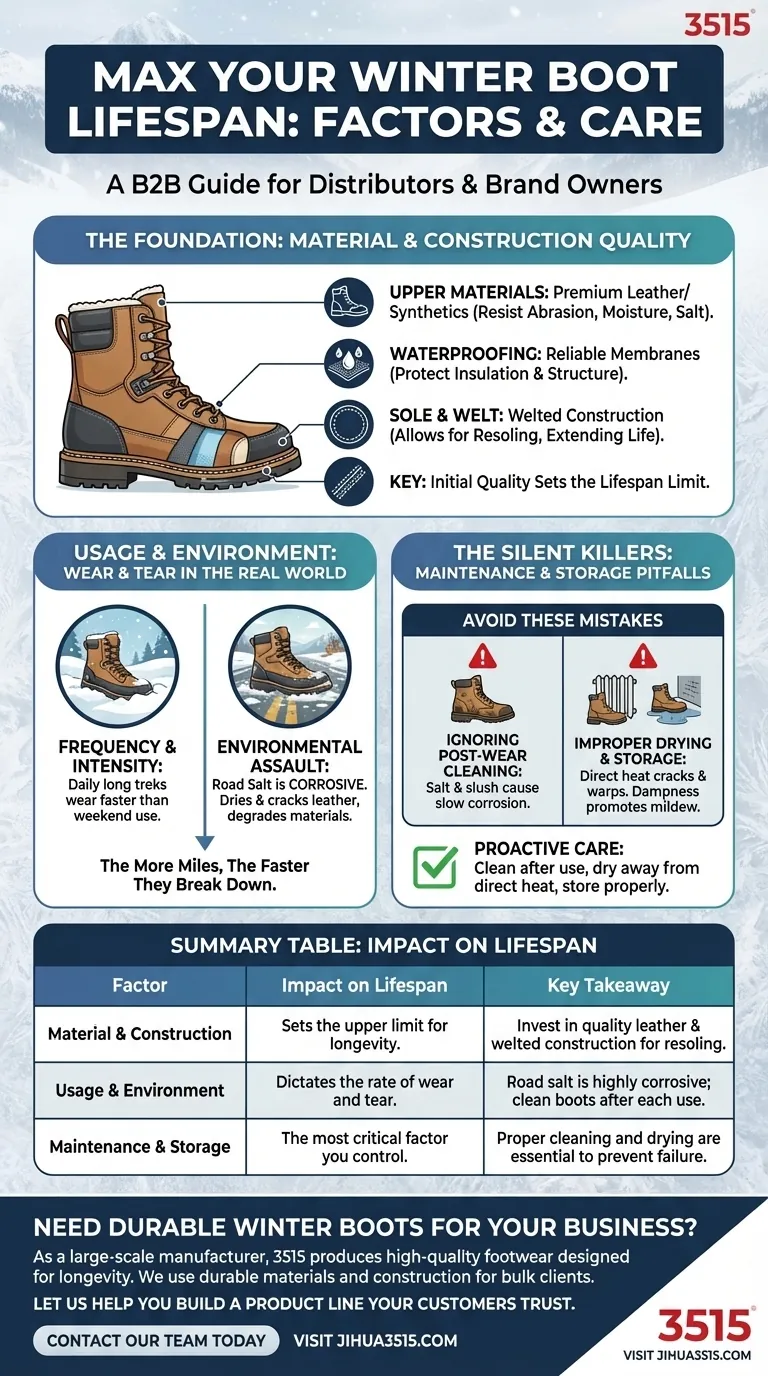The lifespan of a winter boot is not a fixed number; it is a direct result of a dynamic interplay between its construction, its environment, and your care. The most significant factors are the quality of the materials and craftsmanship, the frequency and intensity of use, exposure to harsh elements like road salt, and, most critically, your maintenance and storage practices.
While starting with a well-made boot is essential, the two factors you control—proactive maintenance and proper storage—will ultimately have the greatest impact on how many seasons your boots will last.

The Foundation: Material and Construction Quality
The initial quality of your boots sets the upper limit for their potential lifespan. Cheaper materials and construction methods create failure points that no amount of care can overcome.
Upper Materials: Your First Line of Defense
High-quality uppers, often made of durable leather or advanced synthetic fabrics, provide the primary structure and support. Premium materials are better equipped to resist abrasion, stretching, and damage from moisture and salt.
Waterproofing: More Than Just Dry Feet
A reliable waterproof membrane, like Gore-Tex, does more than keep you dry. It protects the boot's internal structure, including insulation and adhesives, from water saturation, which can lead to material degradation and rot over time.
Sole and Welt: The Secret to a Multi-Decade Lifespan
The sole's rubber compound and tread depth determine grip and wear resistance. However, the most critical construction feature for longevity is the welt—the strip of material that joins the upper to the sole. A welted construction allows a cobbler to easily remove a worn-out sole and replace it, a process that can potentially extend the life of the uppers for decades.
How You Use Them: Wear and Tear in the Real World
No boot is indestructible. How and where you wear your boots dictates the rate at which they will break down.
Frequency and Intensity
A boot worn daily for long treks through deep snow will naturally wear out faster than one used for occasional weekend errands. The more miles you put on them, the faster the sole and high-flex areas will degrade.
The Environmental Assault
Winter conditions are uniquely harsh. Water, ice, and extreme cold are tough, but the biggest threat is often road salt. Salt is highly corrosive; it draws moisture out of leather, causing it to dry, crack, and stain, while also degrading stitching and adhesives.
Common Pitfalls: The Silent Boot Killers
Many boots fail prematurely not from a single catastrophic event, but from a pattern of neglect. Avoiding these common mistakes is crucial for maximizing lifespan.
Ignoring Post-Wear Maintenance
The single most destructive habit is failing to clean your boots after wearing them. Leaving salt, mud, and slush on the surface allows these corrosive elements to slowly eat away at the materials.
Improper Drying and Storage
Placing wet boots next to a radiator or direct heat source is a common mistake. Intense, direct heat can crack leather, warp synthetics, and melt the glues holding the boot together.
Storing Boots Improperly
At the end of the season, simply tossing your boots in a damp basement or hot attic is a recipe for disaster. Excessive moisture promotes mildew, while heat and direct sunlight can make materials brittle. Stuffing them with newspaper or a boot tree helps maintain their shape.
Making the Right Choice for Your Goal
Your approach to buying and caring for boots should align with your intended use and longevity expectations.
- If your primary focus is maximum longevity: Invest in boots with a Goodyear welt that can be resoled and commit to a strict cleaning and conditioning routine after each use.
- If your primary focus is performance in harsh, wet conditions: Prioritize boots with a high-quality waterproof membrane and be diligent about rinsing off salt and dirt to preserve the membrane's integrity.
- If your primary focus is casual use and affordability: You may not need a resoleable boot, but proper cleaning and correct off-season storage are non-negotiable to get the most from your investment.
Ultimately, a few minutes of care after each wear is the single best investment you can make in your winter footwear.
Summary Table:
| Factor | Impact on Lifespan | Key Takeaway |
|---|---|---|
| Material & Construction | Sets the upper limit for longevity. | Invest in quality leather and welted construction for resoling. |
| Usage & Environment | Dictates the rate of wear and tear. | Road salt is highly corrosive; clean boots after each use. |
| Maintenance & Storage | The most critical factor you control. | Proper cleaning and drying are essential to prevent premature failure. |
Need Durable Winter Boots for Your Business?
As a large-scale manufacturer, 3515 produces a comprehensive range of high-quality footwear designed for longevity. Our boots for distributors, brand owners, and bulk clients feature durable materials and construction methods that stand up to harsh conditions.
Let us help you build a product line your customers trust.
Contact our team today to discuss your manufacturing needs and learn how we can deliver reliable, long-lasting winter boots for your market.
Visual Guide

Related Products
- Safety Footwear Wholesale Manufacturer for Custom OEM/ODM Production
- Premium Wholesale Waterproof Safety Boots High Performance Protection for Industrial Markets
- Wholesale Safety Footwear Manufacturer for Bulk & Custom OEM Orders
- Premium Flame-Retardant Waterproof Safety Boots and Shoes
- High Performance Fire-Retardant Waterproof Safety Boots
People Also Ask
- How do safety shoes contribute to cost savings for companies? A Strategic Investment in Risk and Cost Management
- What cultural and environmental considerations are tied to wearing shoes indoors? Balance Hygiene, Tradition, and Foot Health
- What are the cultural perspectives on wearing shoes in the house? A Guide to Home Etiquette & Hygiene
- What are OSHA approved shoes? Understanding the Correct Standards for Workplace Safety
- Do snake bite boots work? Your Ultimate Guide to Effective Snake Bite Protection



















